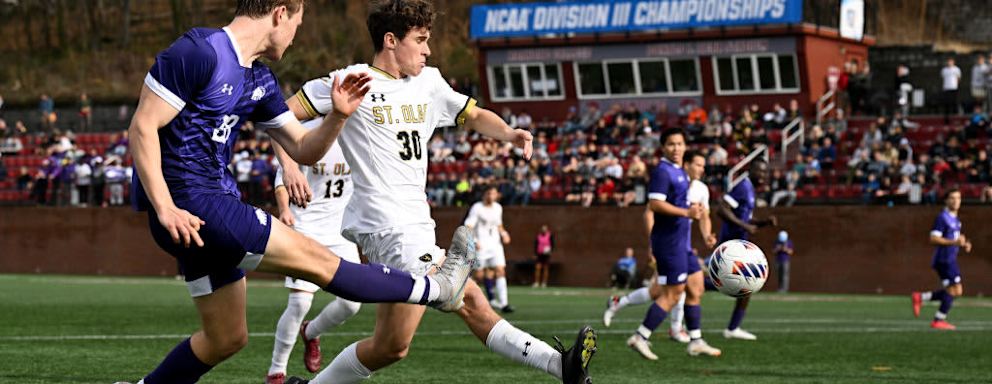Can Athletics Boost Enrollment at Small Colleges?
 Credit: Image Credit: Grant Halverson / NCAA Photos / Getty Images
Credit: Image Credit: Grant Halverson / NCAA Photos / Getty Images- A new study says small colleges investing in athletics might not realize enrollment growth.
- Some colleges have successfully used sports programs to increase enrollment.
- Athletic recruitment can help colleges attract a diverse student body.
You’ve just become president of a small, private college with a shrinking enrollment and a meager endowment. Times are tough for institutions like yours, with closures and mergers abound and the existential threat of a demographic cliff looming on the immediate horizon.
What do you do? Like many others in your shoes, you invest in athletics knowing it has the potential to bolster enrollment.
Only one problem: It might not work. So says a new study of Division III colleges that have tried.
Using Athletics to Drive Enrollment
You won’t see them playing in major bowl games or during March Madness, but schools in the NCAA’s Division III take athletics just as seriously as their nationally televised counterparts in Division I. It’s just that the stakes are lower.
These students don’t receive athletic scholarships, per D-III rules, and few harbor dreams of professional competition. Like D-I schools in the Ivy League and the Patriot League, colleges in D-III enroll true student-athletes who prioritize the “student” aspect of that term.
While powerhouses such as Alabama, Notre Dame, and Michigan may have marquee athletic programs, the “sports culture” at many D-III schools is more prominent. At Amherst College, for example, almost one-third of the students are athletes. At the University of Georgia, that figure is less than 2%.
In fact, 40% of all NCAA athletes play in Division III.
Yet for every Amherst or Williams or Bowdoin — wealthy colleges that can afford to field a wide array of teams, maintain outstanding facilities, and offer healthy financial aid packages when required — there are far more struggling small colleges hanging on by a thread. About 80% of D-III institutions are private.
Last year, Medaille University in New York, a D-III school, closed after nearly 100 years. More recently, Cabrini University, also in D-III, announced that it’s merging with nearby Villanova University.
Since 2020, nine D-III colleges have closed.
Facing threats of extinction, some colleges have invested in athletics as a strategic maneuver to grow enrollment and foster school spirit among its students.
With only 800 students in 2005, Adrian College in Michigan began building up its athletics program. Since then, it has added more than 30 sports and doubled its enrollment. Today, a whopping 70% of the students are athletes.
About 150 miles from Adrian, Calvin University introduced its new football program in 2023, and it already has paid dividends. This fall’s enrollment increased by 15%, with athletes accounting for roughly half of that gain.
Building a robust athletic program requires new facilities, equipment, and additional coaching positions, which can become expensive. But these investments can yield a “big economic reward” in the form of full-paying students attracted by the opportunity to play, Steve Ross, executive director of Pennsylvania State University’s Center for the Study of Sports and Society, told Inside Higher Ed.
Investing in athletics can also yield a more diverse student body, especially through football, though D-III programs are less diverse than their D-I and D-II counterparts, likely because of the lack of athletic scholarships.
Still, in a post-affirmative action world, athletic recruitment can provide a way to help maintain diversity.
“I’ve always been uncomfortable with the rationale for athletics ‘giving’ students of color the opportunity to go to college, which plays into dangerous stereotypes,” David Ridpath, professor of sports business at Ohio University, told Inside Higher Ed. “But schools are looking for a back door to diversity now, and sports are certainly one way to do that.”
Do Athletic Investments Grow Enrollment?
Despite the few examples of institutions realizing salvation through sports, investing in athletics isn’t a “silver bullet” for D-III schools, according to a new report from the Urban Institute.
The study examined 325 D-III colleges, looking at data from 2005 and 2020 to determine if institutions that increased the number of athletic programs or coaches also increased enrollment.
About two-thirds of the schools added programs or coaches. Of them, 45% increased enrollment.
Yet among the colleges that didn’t expand athletics — some 38% of the schools examined — 52% increased enrollment.
“These data suggest that despite the majority of Division III schools investing more in athletics in some way,” the report concludes, “schools that did not invest more were more likely to see enrollment increase.”
That’s not to say athletic investments didn’t positively affect enrollment but rather that it’s difficult to control for other factors and conclude that causation exists.
“Most likely, any effects on enrollment are diminished because schools are trying multiple approaches beyond investing in their athletic programs, such as lowering tuition, increasing student aid, or adding new academic programs,” the report states.
Nonetheless, athletics remains “important to the survival” of many D-III institutions, the report concedes. On the positive side, besides attracting full-pay students who enhance the bottom line, growing an athletics program can strengthen retention because athletes tend to have higher graduation rates than non-athletes.
With more closures potentially in the offing for 2024 and a demographic cliff set to materialize in 2025, colleges desperate to remain open will lurch toward any strategy promising a lifeline, including athletics. This new study, though, should at the very least temper any expectations of dramatic results.